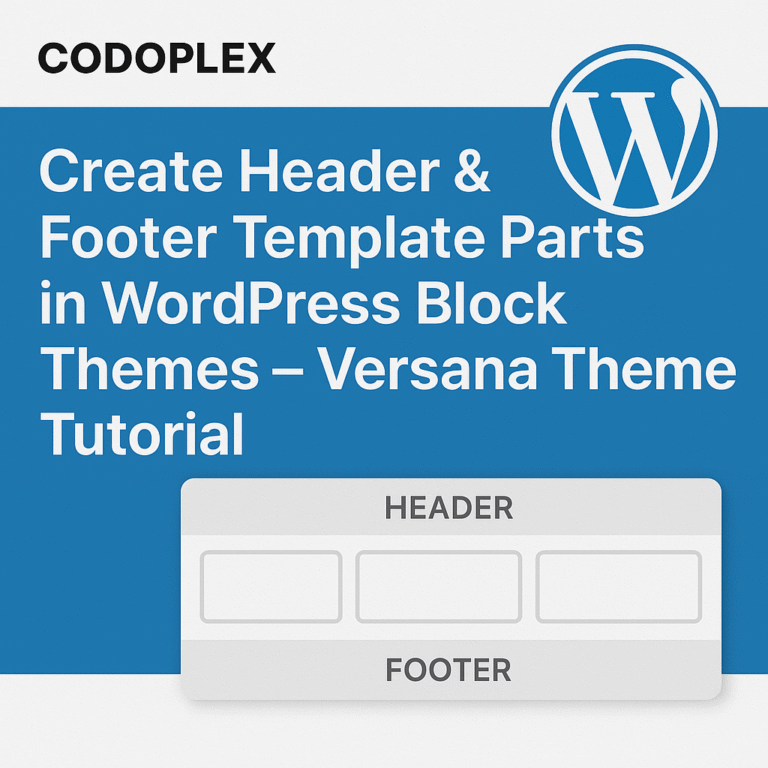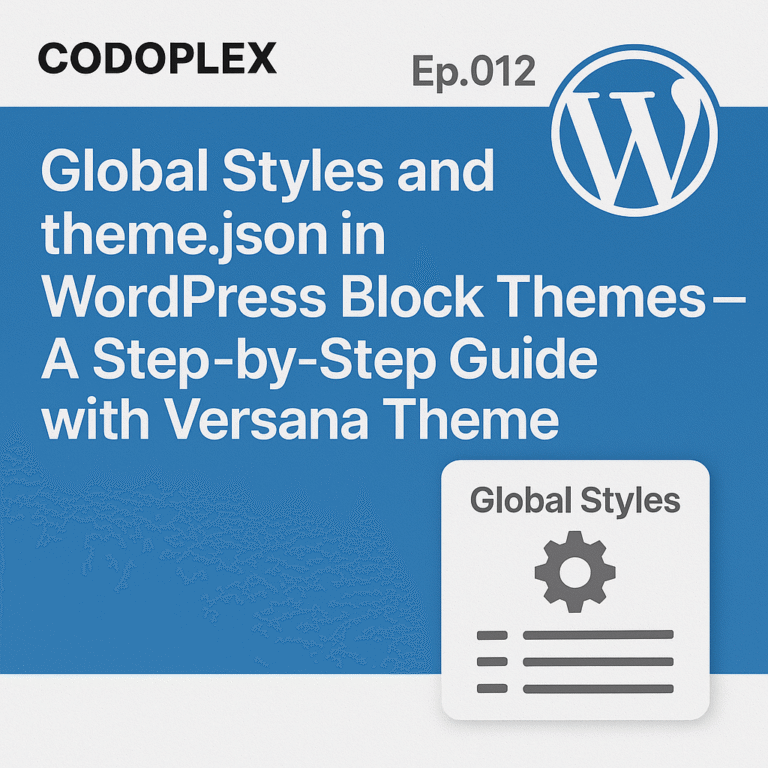Views: 5
When you’re building a WordPress block theme, you’ll constantly use blocks like paragraphs, headings, images, covers, and more. But as a beginner, one of the most confusing parts is the HTML comment syntax used in block templates — those lines that start with <!-- wp:... -->. In this guide, we’ll go through 20 of the most commonly used core WordPress blocks, and for each one, you’ll learn:
- The structure of a block in HTML templates
- What each attribute means (
align,className,dimRatio, etc.) - When and why to use it
- Best practices for real-world theme development
🧩 Understanding Block Syntax First
Let’s look at a simple example:
<!-- wp:paragraph {"align":"center","className":"intro-text"} -->
<p class="intro-text has-text-align-center">This is a paragraph block.</p>
<!-- /wp:paragraph -->🔍 Breaking it down:
<!-- wp:paragraph -->→ This tells WordPress to render a Paragraph Block.{}→ Inside curly braces are block attributes in JSON format."align":"center"→ Controls the text alignment (center, left, right)."className":"intro-text"→ Adds a custom CSS class for styling.<p>→ This is the actual HTML output.<!-- /wp:paragraph -->→ Marks the end of the block.
💡 Tip: Every block has two main parts — its definition comment (<!-- wp:block-name {...} -->) and its closing comment (<!-- /wp:block-name -->).
1. 📝 Paragraph Block
<!-- wp:paragraph {"align":"center","className":"intro-text"} -->
<p class="intro-text has-text-align-center">This is a paragraph block.</p>
<!-- /wp:paragraph -->🧠 Attributes Explained:
"align":"center"→ Aligns text in the center. Possible values:"left","center","right"."className":"intro-text"→ A custom CSS class you can define in your stylesheet.
💡 Why use it:
Paragraph blocks form the body of your page or post. Use the align attribute to position text and className for consistent typography across your site.
2. 🏷️ Heading Block
<!-- wp:heading {"level":2,"className":"section-heading"} -->
<h2 class="section-heading">Section Title</h2>
<!-- /wp:heading -->🧠 Attributes Explained:
"level":2→ Defines the heading level (1–6, corresponding to<h1>–<h6>)."className":"section-heading"→ Helps target this heading in CSS.
💡 Concept:
Heading levels define the content hierarchy. Search engines and screen readers use them to understand structure.
3. 🖼️ Image Block
<!-- wp:image {"id":123,"sizeSlug":"large","linkDestination":"none","className":"featured-image"} -->
<figure class="wp-block-image size-large featured-image">
<img src="example.jpg" alt="Demo" />
</figure>
<!-- /wp:image -->🧠 Attributes:
"id":123→ Image attachment ID (automatically assigned by WordPress)."sizeSlug":"large"→ Image size (thumbnail,medium,large, orfull)."linkDestination":"none"→ Prevents linking the image to a page or media file."className":"featured-image"→ Custom class for styling.
💡 Concept:
Each image inserted in the block editor carries these properties. You can reuse them for responsive design or to control layout.
4. 🌅 Cover Block
<!-- wp:cover {"url":"cover.jpg","dimRatio":50,"minHeight":400,"className":"hero-cover"} -->
<div class="wp-block-cover hero-cover" style="min-height:400px">
<span class="wp-block-cover__background has-background-dim"></span>
<img class="wp-block-cover__image-background" src="cover.jpg" alt="" />
<div class="wp-block-cover__inner-container">
<!-- wp:heading {"textAlign":"center"} -->
<h2 class="has-text-align-center">Welcome</h2>
<!-- /wp:heading -->
</div>
</div>
<!-- /wp:cover -->🧠 Attributes:
"url":"cover.jpg"→ Background image URL."dimRatio":50→ Controls overlay opacity (0–100)."minHeight":400→ Sets minimum height in pixels."className":"hero-cover"→ Used for section-specific CSS.
💡 Concept:
A cover block creates hero sections with background images or videos. The inner-container holds nested blocks like headings or buttons.
5. 🧱 Group Block
<!-- wp:group {"className":"content-wrapper"} -->
<div class="wp-block-group content-wrapper">
<div class="wp-block-group__inner-container">
<p>Inner content</p>
</div>
</div>
<!-- /wp:group -->🧠 Attributes:
"className":"content-wrapper"→ Defines outer container styling.
💡 Concept:
Think of the Group block as a div wrapper — it helps you apply backgrounds, padding, or layout structure to multiple inner blocks.
6–7. 🧩 Columns and Column Blocks
<!-- wp:columns {"align":"wide","className":"three-columns"} -->
<div class="wp-block-columns alignwide three-columns">
<!-- wp:column -->
<div class="wp-block-column"><p>Column 1</p></div>
<!-- /wp:column -->
<!-- wp:column -->
<div class="wp-block-column"><p>Column 2</p></div>
<!-- /wp:column -->
</div>
<!-- /wp:columns -->🧠 Attributes:
"align":"wide"→ Makes columns stretch wider than content width."className":"three-columns"→ Custom class for layout styling.
💡 Concept:
Columns create responsive layouts. Use "wide" or "full" alignments for horizontal spacing control.
8. 🖼️ Media & Text Block
<!-- wp:media-text {"mediaPosition":"right","mediaType":"image","className":"media-section"} -->
<div class="wp-block-media-text has-media-on-the-right media-section">
<figure class="wp-block-media-text__media"><img src="image.jpg" alt="" /></figure>
<div class="wp-block-media-text__content">
<h3>Heading</h3><p>Description text.</p>
</div>
</div>
<!-- /wp:media-text -->🧠 Attributes:
"mediaPosition":"right"→ Moves the image to the right side."mediaType":"image"→ Defines the type (image/video)."className":"media-section"→ For consistent section styling.
💡 Concept:
This block is perfect for marketing or feature sections combining visuals and text.
9. 💬 Quote Block
<!-- wp:quote {"className":"testimonial"} -->
<blockquote class="wp-block-quote testimonial">
<p>This is a quote block.</p>
<cite>Author</cite>
</blockquote>
<!-- /wp:quote -->🧠 Attribute:
"className":"testimonial"→ Adds a unique style for quote boxes or testimonials.
💡 Concept:
The Quote block enhances readability by isolating key statements or testimonials.
10. ✨ Pullquote Block
<!-- wp:pullquote {"className":"highlight-quote"} -->
<figure class="wp-block-pullquote highlight-quote">
<blockquote>
<p>A highlighted quote</p>
<cite>Someone</cite>
</blockquote>
</figure>
<!-- /wp:pullquote -->💡 Concept:
A pullquote is a visual quote used to grab attention. It supports background and text colors, ideal for magazine-style layouts.
11. 🔢 List Block
<!-- wp:list {"ordered":true,"className":"numbered-list"} -->
<ol class="numbered-list"><li>First</li><li>Second</li></ol>
<!-- /wp:list -->🧠 Attribute:
"ordered":true→ Uses<ol>instead of<ul>(ordered list)."className":"numbered-list"→ Custom styling.
💡 Concept:
Lists improve readability for steps, features, or key points.
12. 🧭 Navigation Block
<!-- wp:navigation {"className":"main-menu"} /-->🧠 Attributes:
"className":"main-menu"→ CSS class for header styling.
💡 Concept:
Used inside your header.html template to display menus dynamically.
13–15. 🌐 Site Blocks
🖼️ Site Logo
<!-- wp:site-logo {"width":120,"className":"site-logo"} /-->"width":120→ Logo width in pixels.
🏷️ Site Title
<!-- wp:site-title {"className":"site-title"} /-->
💬 Site Tagline
<!-- wp:site-tagline {"className":"site-tagline"} /-->💡 These three work together in your site header for branding consistency.
16. 📰 Post Title
<!-- wp:post-title {"level":1,"className":"post-heading"} /-->"level":1→ Ensures it uses<h1>tag on single post pages.
💡 Concept: Displays the title of the current post or page dynamically.
17. 📄 Post Content
<!-- wp:post-content {"className":"entry-content"} /-->💡 Displays the main content written in the editor. Usually wrapped inside the <main> element.
18. ✍️ Post Excerpt
<!-- wp:post-excerpt {"moreText":"Read More","className":"post-excerpt"} /-->"moreText":"Read More"→ Custom text for the “Read More” link.
💡 Concept: Used in blog archives or query loops.
19. 🔘 Buttons Block
<!-- wp:buttons {"className":"cta-buttons"} -->
<div class="wp-block-buttons cta-buttons">
<!-- wp:button {"className":"primary-btn"} -->
<div class="wp-block-button primary-btn"><a class="wp-block-button__link">Click Me</a></div>
<!-- /wp:button -->
</div>
<!-- /wp:buttons -->🧠 Attributes:
"className":"cta-buttons"→ Styles the button group."className":"primary-btn"→ Styles the button itself.
💡 Concept: Used for call-to-action sections (CTAs).
20. ➖ Separator Block
<!-- wp:separator {"className":"section-divider"} -->
<hr class="wp-block-separator section-divider" />
<!-- /wp:separator -->"className":"section-divider"→ Adds a custom divider style.
💡 Concept: Use between sections for visual separation.
🧭 How to Read Any Block Syntax
You can understand any block by remembering this formula:
<!-- wp:block-name {"attribute":"value"} -->
HTML output here
<!-- /wp:block-name -->- Everything between the comments is the rendered content.
- Attributes inside
{}define the block’s behavior and styling. - You can edit them manually in your
templates/orpatterns/folder.
💡 Best Practices Summary
| Purpose | Attribute | Why It’s Important |
|---|---|---|
| Layout | align, minHeight, dimRatio | Controls size, position, background |
| Design | className, style | Allows custom CSS styling |
| Content | level, ordered, moreText | Defines hierarchy or display options |
| Reusability | Consistent class naming | Keeps your theme maintainable |
🎓 Conclusion
Once you understand these 20 core blocks and how attributes define their behavior, building templates becomes effortless. Each attribute tells WordPress how to display a block — alignment, spacing, background, color, or hierarchy.
Next up, we’ll explore Block Patterns — where you’ll combine these blocks to build reusable design sections for your Versana theme.

